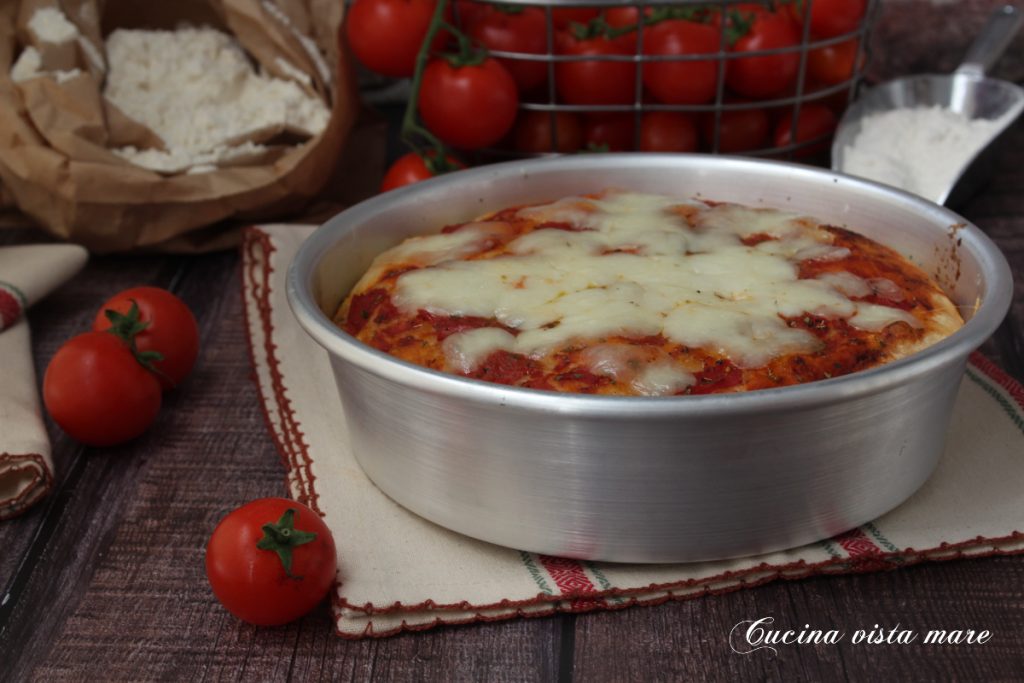The pan pizza is a traditional recipe from Turin: what makes it special is the cooking inside a well-oiled iron or aluminum pan. During baking, the pizza rises creating a high, fluffy edge with a crispy base if you use the iron pan or a softer one with the aluminum pan. The original recipe states that the pan pizza should rise for six/eight hours and then another 12/24 hours in the pan. But such a long rise that I now do ‘routinely’ can scare and discourage many, so this time I set aside the original recipe to follow a simpler, homemade method. The dough is really simple and in no time you can enjoy a fluffy, thick pizza with a classic topping!

- Difficulty: Easy
- Cost: Economical
- Rest time: 3 Hours
- Preparation time: 20 Minutes
- Portions: 2/4 people
- Cooking methods: Electric oven
- Cuisine: Regional Italian
Ingredients
- 4 cups all-purpose flour
- 1 1/4 cups water
- 0.28 oz fresh yeast
- 1 teaspoon sugar
- 2 teaspoons salt
- 2 tablespoons extra virgin olive oil
- 6 oz peeled tomatoes
- 6 oz mozzarella
- to taste extra virgin olive oil
- to taste salt
- to taste oregano
- to taste basil
Tools
- 2 20 cm aluminum pans
- 1 Stand Mixer Kitchen Aid Artisan
Steps
Before starting: if you decide to use two 20 cm molds, weigh the dough after kneading and divide it into two parts. Transfer each dough into a well-oiled bowl and let it rise. This is important because after rising, the dough should not be touched: simply invert the bowl onto the mold and the dough will fall on its own. Cutting it after rising will ruin the dough. If you use just one mold, naturally, leave the dough whole.
Since there was some controversy over using a ‘wrong’ mold for this recipe, I want to clarify. For this pizza, I used molds I already had at home. You’ll agree it’s not possible to have all possible sizes of trays and molds in a regular kitchen. The mold for pan pizza should be a bit lower, but I made do with what I had. If you find lower molds, feel free to use them. In pizzerias (and I know this because I’ve taken courses in professional settings), ‘blue trays’ are typically used. When first used, they undergo a ‘burn-in’ at high temperatures to create a non-stick layer and prevent rust. After one or two ‘burn-in’ cycles, the trays are ready for use and should never be washed. They should always be kept oiled. In pizzerias, the trays are used continuously, renewing the non-stick layer with each bake. Doing this at home isn’t easy unless you have a high-temperature oven (300 °C and above) and it’s not advisable to keep a tray oiled with the risk of it going rancid. Washing it in water will cause rust, and you’ll just have to throw it away. So unless you make pizza every day (or very often) like in a pizzeria, it’s not worth venturing down this path. Here we discuss recipes easily replicable at home with the tools (sometimes few) that everyone has. Want to try the right tray, want to try the burn-in process because you’re passionate? Go ahead. Online you can find many videos explaining it in detail. HERE you see the blue tray with a 20 cm diameter and 2.5 cm height for pan pizza. But remember, if you choose this, it requires ‘burn-in’, don’t try to use it like a classic tray or it will be a disaster.
In the mixing bowl using the spiral hook, add the flour and the water in which the yeast has been dissolved with the sugar and start kneading. When the dough is wrapped around the hook, add the salt and oil gradually and continue kneading until the dough is smooth and homogeneous. Transfer it to a lightly floured work surface and fold it a few times to strengthen the gluten network. Form a ball and place it in a bowl. Cover it and let it rise until doubled in a warm place: it will take about two to three hours.
After the resting time, generously oil the pan, transfer the dough to it, slightly spread it, and let it rest (it needs to relax) for fifteen minutes, then spread it to the edges. If using two molds, you need to divide the dough in two. Let it rise in the tray for forty minutes.
Meanwhile, cut the peeled tomatoes into small pieces and season them with oil, salt, and oregano. Preheat the oven to 392 °F. Top the pizza with the tomato and bake for thirty minutes, then add the diced mozzarella (better a mozzarella for pizza as it is drier), and bake again just long enough to melt it.
Serve the pan pizza nice and hot!

Recipe source: HERE.
If you prefer a less thick pizza, use a 26 cm mold or four 20 cm molds.
This content contains one or more affiliate links.

